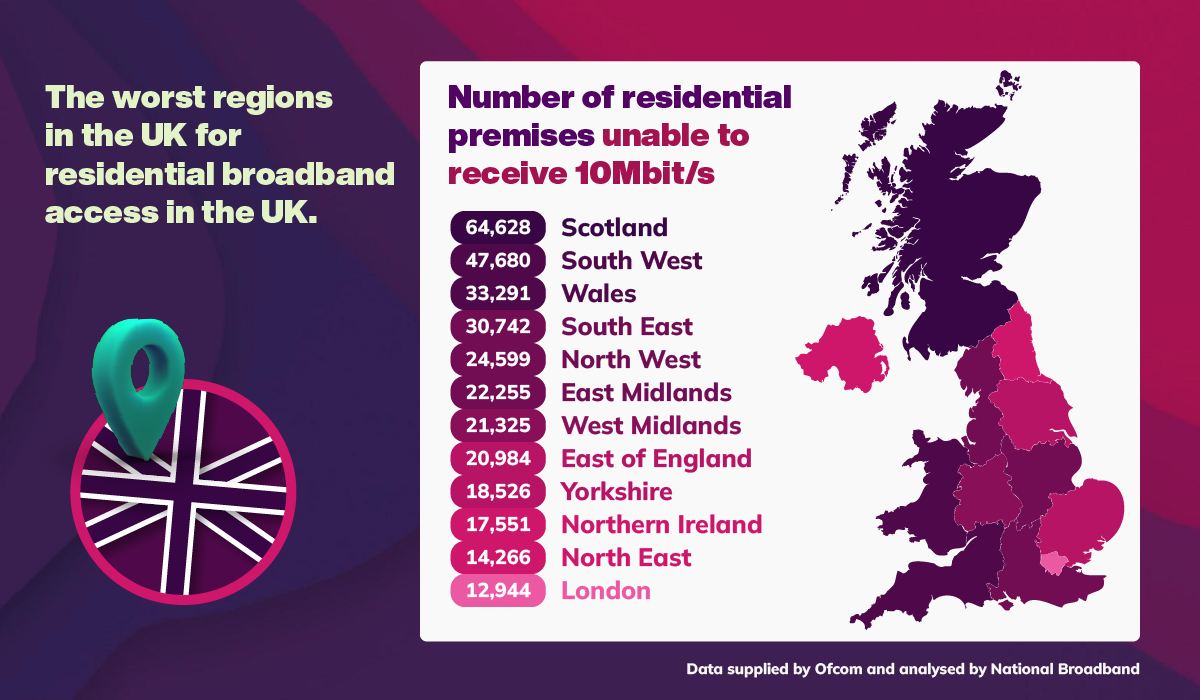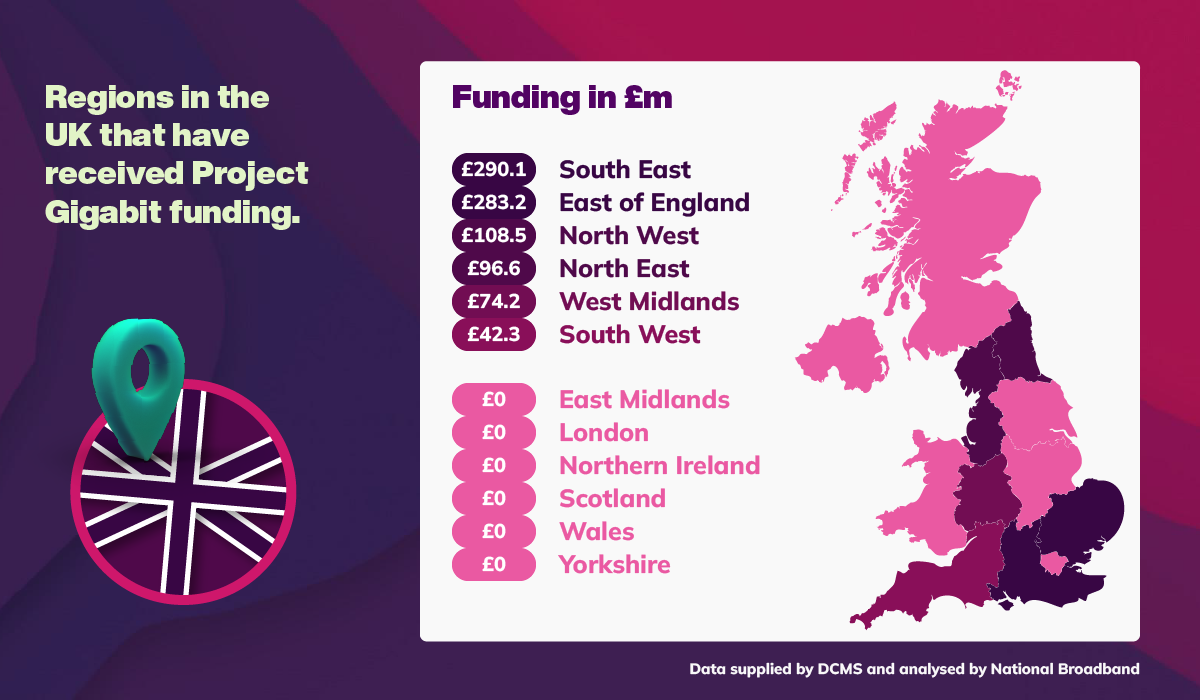David Hennell from National Broadband examines how central government broadband policy is failing to provide assistance to the nation’s most digitally disadvantaged properties and discusses alternative solutions that should be leveraged
With less than 18 months to go until the Government’s target date to provide 85% of UK properties with access to gigabit-capable broadband, it is clear from Ofcom and DCMS/DSIT supplied data that Project Gigabit funding is largely being spent on easier and cheaper to reach areas in order to reach this target.
Homes Without Broadband
Admittedly, Project Gigabit, the Government’s flagship broadband policy, has yet to allocate the whole of its £5bn budget, but its current progress already highlights clear issues within its approach, given that it is solely focussed on the roll-out of full-fibre broadband.
Although, according to Ofcom, the Government is on track to reach its self-set target by 2025, when it comes to improving rural broadband, the devil is in the detail. Analysis of available data shows that to reach this objective, Project Gigabit funding is more often than not being applied to more densely populated areas that are easier and cheaper to provision.
Analysis of data both from Ofcom’s regular reporting and gained through an FOI request submitted to DCMS (now DSIT) reveals the following key points:
• 50% of UK homes that have no access to what Ofcom defines as “decent” broadband via landline have yet to receive any funding from Project Gigabit
• The already well-served South-East and East of England have received the most funding from Project Gigabit to date, with both regions each receiving over £250m
• Wales, Scotland and Northern Ireland are yet to receive any funding from Project Gigabit, along with Yorkshire and the East Midlands.
• Scotland fares the worst in the UK for broadband, with well over 60,000 residential properties unable to access broadband speeds of even 10Mbps

Ofcom’s latest Connected Nations update, published in May this year, reveals that there are over 435,000 UK premises that still cannot get “decent” broadband down a landline. It has set a low bar in defining that minimum threshold as needing to be above 10 Megabits per second (or Mbps).
Over 75% of those digitally deprived properties are homes, and a staggering 50% of those residential properties without access to acceptable broadband have yet to benefit from any Project Gigabit funding. That represents 330,000 homes which cannot perform even simple online tasks, such as video calling or streaming.
Despite some funding being distributed, there are significant and counter-intuitive disparities between regions. The South-West, which has the greatest number of premises in England unable to access landline broadband at speeds higher than 10Mbps, has only received £42.3m from Project Gigabit, whereas both the South East and East of England have received over £250m each.
This equates to the East of England receiving over £13,000 per property deprived of decent broadband, and the South-East over £9,000 per property, compared to just £887 for the South West. Scotland, which according to Ofcom has almost 65,000 broadband-starved homes and which is by some considerable way the poorest UK region for connectivity, has to date received no project Gigabit funding. Nor has Wales, Northern Ireland, the East Midlands or Yorkshire.
In fact, when the data is examined more closely, only one out of the ten local authorities with the very worst broadband connectivity in the UK even lies within a region that has to date received any funding from Project Gigabit.
Solutions
The irony is that solutions to radically improve the connectivity of the nation’s most digitally disadvantaged homes and businesses exist today. They are both cost-effective and extremely quick to deploy – but they simply don’t enter Government’s fibre-fixated thinking.
Alternative broadband delivery solutions such as 4G broadband or satellite broadband must also be considered for all areas where it is too time-consuming and/or too costly to deploy full fibre. Ofcom itself has stated that the vast majority (85%+) of properties currently unable to access a minimum acceptable broadband performance via landline could indeed have their connectivity significantly improved by utilising 4G. For the hardest-to-provision remainder, satellite-delivered broadband remains the viable alternative.
We have calculated that the cost of using alternative technology to supply every single one of the 435,000 properties currently without access to usable broadband with equipment capable of providing a much faster connection would come to a cost of less than 3% of Project Gigabit’s total £5 billion budget.
Closing the gap
There is a clear and growing disparity between digital “haves” and “have nots” in the UK and, as Project Gigabit fails to address more remote and more difficult-to-provision areas, this digital divide will only worsen. Far too many rural communities are still endlessly waiting on the distant promise of full-fibre broadband – and yet the Government is ignoring proven alternatives which would dramatically improve people’s connectivity at a fraction of the cost of fibre.
This is counter-intuitive, to say the least, because under Project Gigabit, full fibre connectivity is being funded for properties that already benefit from perfectly good broadband performance, while properties in more rural and harder to reach areas which are typically those suffering with the poorest landline broadband speeds are being excluded.
Other Government policies such as the Universal Service Obligation (or USO) that was intended to provide a safety net for those with the worst connectivity have already been shown to be simply not fit for purpose.
It is of course, a given that expanding the roll-out of full fibre broadband is a good thing for the nation. However, it is almost impossible to understand why other solutions are not also being funded for those who have the very worst current connectivity – simply put, why are those most in need being left out?
If the Government is serious about its commitment to digital levelling up, it is vital that it expands its view on how best to improve connectivity for the entire nation. Otherwise, the pursuit of its self-set target to provide 85% of UK properties with gigabit-capable broadband is set to widen rather than close the digital divide that persists in the UK.

This work is licensed under Creative Commons Attribution-NonCommercial-NoDerivatives 4.0 International.












